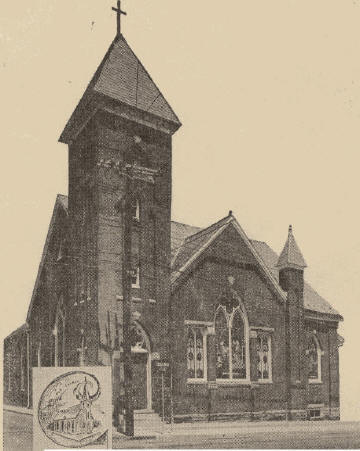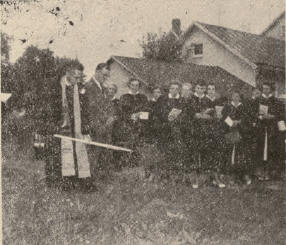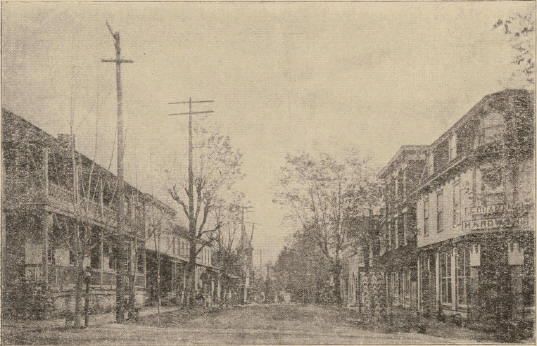|
Gateway to the Mountains
George Wireman
Chapter 18: Trinity United Church of Christ
 Apple's Church, located about one mile east of Thurmont, was the mother
church of both the Lutheran and Reformed denominations in this immediate area. Trinity United Church of Christ is a direct representation of the Reformed
congregation at Apple's, having been organized on April 15, 1770. Apple's Church, located about one mile east of Thurmont, was the mother
church of both the Lutheran and Reformed denominations in this immediate area. Trinity United Church of Christ is a direct representation of the Reformed
congregation at Apple's, having been organized on April 15, 1770.
The Reformed Church, notwithstanding its many adversities, still maintains a congregation at Apple's. The Centennial of that
organization was celebrated in 1870, by the Rev. N. E. Gilds, who was the Reformed pastor of the congregation at the time. From his centennial sermon we learn
that in 1857 the Lutheran congregation withdrew from Apple's and built for themselves a church in Mechanicstown. In the twenty-two years that followed, the
Re-formed congregation struggled to hold its membership. The old church building was repaired at an expense of $1,300.00, but even this improvement failed to
hold the congregation in check. Many were being absorbed by the churches in the town and once there, they could not be enduced to attend services in the
country.
Rev. Gilds, in his centennial sermon said, "The time is here when we should go to town." It required but a feeble forecast of
the future, to see what the end would be, if the congregation remained in the country.
Rev. Henry Wissler, of Duncannon, Pennsylvania, was elected to succeed Rev. Gilds, who left Apple's Church in September, 1874.
Rev. Wissler was installed on October 1, 1875 and by this time the congregation had begun in earnest to agitate the expediency of a change in location. Finally,
on Christmas Day, 1877, Rev. Henry Wissler was authorized to call a special meeting of the consistory, when the following preamble and resolutions were adopted:
"Whereas, it has become apparent that our church here, is not prospering as we would wish. And whereas, we believe it is
owing to the peculiar location of the church, being situated aside from any central place of business. And, where-as, we further believe that it is our
Christian duty to use honorable means, by which we may promote the prosperity of our church in this community. And, whereas, we further believe, that, by
building a church in Mechanicstown, we will be able to do more efficient work, and thus prosper more. Therefore, Resolved: That we forthwith, make every
reasonable effort to secure the means, and build a house of worship for ourselves in Mechanicstown, Maryland."
After due consideration by all present for and against, the pre-amble and resolutions were adopted. A committee was at once
appointed to select a site and to solicit subscriptions, consisting of Uriah Warrenfeltz, W. L. Firor and D. S. Firor. This same committee was subsequently
appointed as the building committee.
In the meantime, another move was on foot to build a church in Graceham. A lot had been donated by Dr. George M. Zimmerman, and
over $800.00 had been subscribed, but because of a forward circumstance, it was subsequently abandoned.
In view of the divided opinion prevailing in the congregation, the entire matter was laid before the Classis of Maryland, at
its annual session, convened in Mechanicstown on May 31, 1878. The subject was put into the hands of a special committee, consisting of Rev. A. R. Kremer, Rev.
O. E. Lake, and elder G. S. Griffith; who after a full and impartial investigation of all the facts, recommended that the Reformed congregation at Apple's be
earnestly advised by the Classis, to continue, and carry forward to completion, the work of building a church in Mechanicstown. The report was received and
adopted.
The building committee met with considerable difficulity in se-curing the means and finding a suitable location. It was not
until the spring of 1879, that they found themselves justified in commencing the work.
A lot situated on East Main Street, where the church now stands, was finally purchased from William Cover's estate, for the sum
of $900.00. On Monday, October 13, 1879, ground was broken and the work was commenced. On November 1, 1879, the corner stone was laid with appropriate services.
The Rev. J. S. Kieffer, of Zions Church in Hagerstown, preached a very edifying sermon on that occasion.
The new church was dedicated on June 13, 1880, when Rev. M. L. Firor of St. Paul's Church, Baltimore, preached the sermon.
Due to ill health, Rev. Wissler was forced to give up the ministry in 1884. In the four years under his leadership, the
membership of Trinity church in Mechanicstown rose from 52 initial members to secure better Sunday School accommodations, even if it became necessary to remodel
the whole church building.
The building committee consisted of Dr. E. C. Kefauver, M. L. to 140. The wisdom of this new organization was more than
justified. During this brief period, Rev. Wissler had baptized 28 children, solemnized 9 marriages and officiated at 24 funerals.
On April 1, 1885 Rev. A. B. Stoner succeeded Rev. Wissler at Trinity. During his pastorate, which lasted only three years, Rev.
Stoner added 24 new members and baptized 24 children.
The Reformed charge, consisted of six congregations; Trinity, Creagerstown, Rocky Ridge, Apple's, Sabillasville and St. Jacobs.
It was during Rev. Stoner's pastorate that the charge was divided. Sabillasville and St. Jacobs were detached and a newly formed congregation at Highfield,
constituted a new charge known as the Sabillasville charge. This change, which also brought about the need for an additional pastor, was the direct result of
Trinity congregation's determination to prove that the move to Mechanicstown from Apple's was justified.
Rev. Stoner closed his labors at Trinity on May 1, 1888 and the charge was vacant until January 1, 1889, when the Rev. George
A. Whitmore became the new minister.
At this time a debt of $500.00 still rested upon the church, but in the course of two years, through the liberality of a few
faithful members, this debt was cancelled and a number of improvements were made. Repairs to the parsonage, the removal of the fence in front of the church, the
renovation of the church, new pulpit furniture, were but a few of the many improvements. A fine walnut library case and a secretary were added to the Sunday
School. A pipe organ, the first one in town, was installed and new hymnals were provided, all at a cost of $700.00.
The steady growth of the congregation and the Sunday School made it fully apparent that a primary room suitable for the
christian nurture of the little ones was necessary. To meet this need, the gallery was fitted up, at a cost of $100.00 more. This new arrangement proved to be
inadequate and unsatisfactory.
The necessity for a proper place for the youth of the church brought about considerable agitation and finally on July 20, 1901,
the consistory was authorized to make the necessary changes so as Creager, Samuel Long, C. I. Creeger, J. W. Creeger and the pastor, Rev. Whitmore. Architect O.
Scott of Hagerstown, prepared the plans and specifications, which, after some delay, were finally adopted by the consistory and given to the building committee.
Ground was broken on the first day of September, 1901. Owing to the energy of the building committee, with Dr. Kefauver as
Chairman, and being blessed with favorable weather, the work was pushed forward so rapidly that on October 26, the corner-stone was laid with appropriate
ceremonies. Acacia Lodge, No. 155, A.F. and A.M. of Thurmont assisted in performing the mechanical work and was ably represented in a masterly address by
Senator Jacob Rohr-back, of Lynch Lodge of Frederick, Maryland. The consecration of the corner-stone was performed by Rev. Whitmore and Rev. Charles D.
Schaffer, a former member of the congregation, delivered an eloquent sermon for the occasion.
When the work was completed the congregation was more than pleased with the results. A new auditorium, a main Sunday School
room, a primary and two bible class rooms had been added at a cost of about $8,000.00.
During the construction of the building, the Methodist Church had made available their facilities to the congregation, and
Trinity services continued, uninterrupted. They used these facilities for about three months, when the main Sunday School room was sufficiently completed to
enable them to occupy it, until the church was ready for dedication.
The dedication services were held on July 20, 1902, twenty-two years and one month after the dedication of the first edifice.
All due preparation was made for this occasion. Services were held the week previous, when the following ministers were present and took part in the service:
Rev. D. N. Ditmar, Dr. A. S. Weber, Dr. S. L. Whitmore, and Rev. J. C Bowman, of the Theological Seminary, Lancaster, Pennsylvania, who preached the dedicatory
sermon. The services were largely attended and the offerings were liberal.
As mentioned before, the entire cost of the improvements amounted to about $8,000.00, over $5,000.00 of which had been provided
for and raised on the day of dedication. The remainder was assumed by the consistory and the various organizations of the church.
Thus, in the course of twenty-five years, the congregation had practically built two churches, at a cost of over $11,000, and
in addition, raised for benevolent and congregational purposes over $20,000 more, which amounted to an average of over
$800.00 per annum.
In 1906, Guy P. Bready was installed as pastor of Trinity and remained until 1909. From 1909 to the present, the church was
under the leadership of a number of fine ministers and the member-ship enjoyed a steady growth along with the community. The following ministers served Trinity
during this period:
- Rev. John W. Reinecke 1909-1910
- Rev. J. B, Shontz Supply Pastor
- Rev. Peter E. Heimer 1913-1929
- Rev. Edward D. Bright 1931-1946
- Rev. William H. Groff 1947
- Vacant 1948-1950
- Rev. Edouard H. Taylor 1950-1955
- Rev. Samuel A. Moyer 1957-1962
During the pastorate of Rev. Samuel A. Moyer, the Evangelical and Reformed Churches merged with the Congregational Christian
Churches and became known as The United Church of Christ. The local church maintained the original name, Trinity, adding the words "United Church of Christ" in
place of Evangelical Reformed.
Trinity had grown considerably during the years that followed World War II. As a result of this growth the Sunday School
facilities became inadequate and it was necessary to provide additional accommodations. Under the leadership of Rev. Samuel A. Moyer, Trinity congregation met
this challenge, having received the following message of inspiration from its pastor:
"We, of Trinity Church, have inherited a Church and Christian education facilities that, in the past have well served the
Church at large, the community, the state and the nation.
"Our forefathers sacrificed much to provide for themselves these facilities. They served them well, and we have used them
too. Now, however, due to great changes in educational procedures, as well as increase in enrollment, the time has come to expand and to better these
facilities. A new day demands new facilities to meet its challenge.
"We are most mindful of what has been done for us. Now, to show our appreciation, we must accept the challenge, the sacrifice
and the investment which today and the future holds for us. Let us, through this project, help to leave our world a little better than we found it."
Sincerely,
Samuel A. Moyer
|

Ground Breaking Ceremonies for New Building
|
The new facilities, erected in the rear of the church, was completed in 1958 and consisted of a large auditorium, complete with
stage, a kitchen, five classrooms and a study for the pastor. Once again Trinity had fulfilled its responsibility in providing proper facilities for its
children and youth, in an age that needs so much.
In 1962, Rev. Moyer left Trinity and Rev. Richard Ruof became pastor of the charge which includes Trinity, Apple's and Mt.
Tabor at Rocky Ridge.
Rev. Ruof served Trinity charge for five years and left Thurmont in the summer of 1967 to accept a charge in up-state New York.
In the absence of a regular minister, the Rev. Nevin E. Smith of Hagerstown acted as Supply Pastor.
A history of Trinity church would not be complete without mentioning the Aid Society and The Gleaners Beneficent Association,
known as the Missionary Society, both of which have rendered splendid service in their time. The King's Daughters, organized in 1889 and still very active, has
been most helpful through the years, raising funds for various church projects and helping with charitable work in the community.
With these splendid facilities now at hand, Trinity United Church of Christ renews its pledge of allegiance to the building of
God's kingdom here upon earth.

Main Street Looking East
Chapter Index |
Chapter 19: Independence Day — 1876
If you have any Information or historical news clippings on events in the
Thurmont Area, Please send them to us so we can included them in our archives. E-mail us at: history@mythurmont.net |